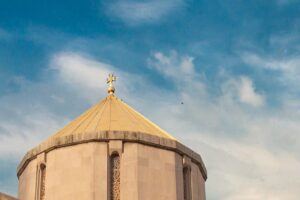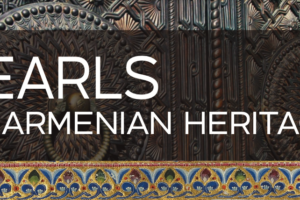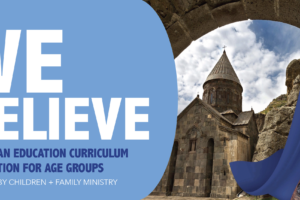Gregory of Narek and Mary: Mother of God, Mother of Light, Mother of the Word

It may be difficult for some of us to warm up to the idea of Mary, the Virgin Mother of God.
Perhaps we were raised under the influence of traditions less hospitable to the notion of a human who became the gestational space for the divine and thus gained greater than human status herself.
Perhaps our scientific mind balks at the notion of combining virginity and childbirth.
Perhaps we did not experience good mothering, and so images of motherhood do not resonate with us.
Perhaps we simply have not thought about it much because we have taken Mary for granted as part of our faith landscape since childhood.
Gregory of Narek could easily have fallen into either of the last two categories. But he didn’t. Deprived of mother love at an early age and raised in the shadow of a church named for Mary as Mother of God, he resonated with her deeply and grew into a profound understanding of her significance human and cosmic, historic and eternal.
In his praises of and prayers to Mary, Gregory uses more than one hundred images to express her fundamental role in the world’s salvation. From the ark of Noah by which life on earth was restored, to the ark of the covenant as the seat of God’s presence amid the Israelites, to the Church that shelters the faithful and whose font produces newness of life through its womb-like waters, every container in Scripture serves as an entryway into some aspect of her meaning. Plants from the Tree of Life in Eden to the rods of Moses and the high priest Aaron to the Tree of Jesse and the Tree of the Cross bespeak her expression of the creative Fruitfulness that is a fundamental principle of life in Christ.
And yet, with all her many beautiful descriptions as things of sacramental holiness and value — as the East, altar, tabernacle, sanctuary, chariot, harbor, cup, cloud, burning bush, sealed spring, pearl, field, door, ladder, mountain, key and diadem — Mary’s overarching image, the role for which we and Gregory know and love her best, remains that of Mother. Gregory describes her not only as Birth-giver of God and Mother of the Lord, but also as Mother of the Indescribable Light, Mother of the Word, and Mother of all the living — including us.
As she had been giver of life to Life, Gregory called upon her to make his own inevitable death a source not of fear but of festive anticipation. With her to escort him from this earthly valley, where else could he be going but to renewed life?
Gregory did not leave it at that, however. Yes, Mary’s motherhood was a consolation to him personally, but it was also a challenge. He realized that he was called to live out the same roles that she had played in human salvation by embodying and expressing the Word God in purity, by birthing into the world’s darkness the creative and all-benevolent Light, by being a gestational space for the life-giving and life-enhancing nature of the divine into the human experience.
Gregory knew that while literal motherhood is not a part of everyone’s mission, we are all mothers nonetheless. We may not even aspire to motherhood, and yet we all attain it. No matter our gender or physical fertility, we engender what is like ourselves and yet more than ourselves, birthing it into the world around us; whatever we have and have become, we pass on to others who will become that and more, in a manifestation that differs greatly, perhaps, from our own. At the very least, our ideas and words are the offspring of our minds and hearts. Our actions and our repeated patterns of behavior are the offspring of our ideas and experiences. We are all mothers, all the time. Like Gregory, may we come to have the assurance that no matter when or how we depart this world, we go toward the same Light and Life to whose creative words and healing deeds we have spent a lifetime giving birth.
Tag:St. Mary





1 Comment
Thank you Prof Ervine. I have been asking about the understanding of the Mother of God in Armenian tradition, particularly devotion, and I really appreciate the beautiful experience of Gregory of Narek. It is seemingly difficult to find resources on this, also I don’t speak Armenian. I have taken various theology courses in the Orthodox tradition, but I would appreciate if it is possible to read more of your translations and even possible take a course with you. My email is required below, I hope you may contact me with it.